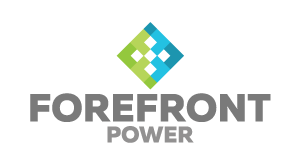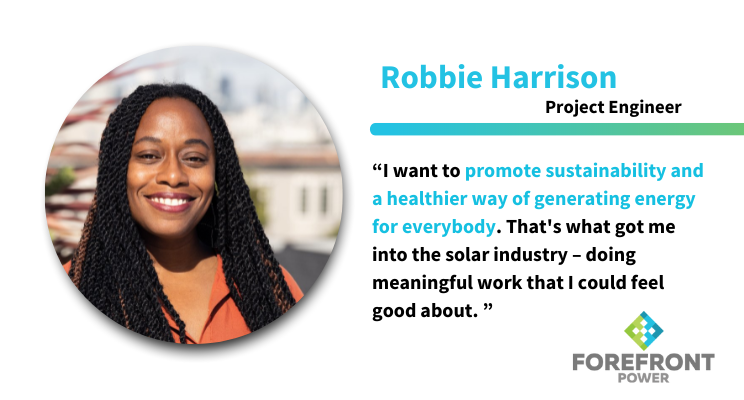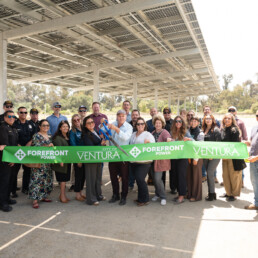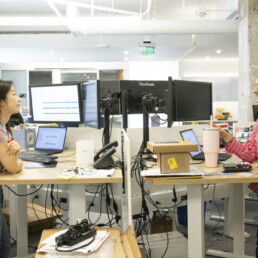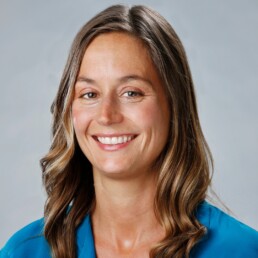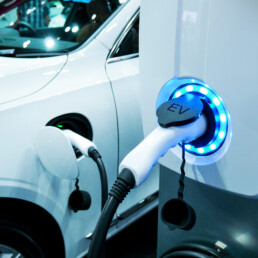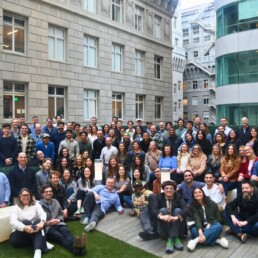We spoke to ForeFront Power Project Engineer Robbie Harrison to learn how her interest in sustainability led her to the solar sector, and hear her advice for women and people of color looking to pursue a STEM education and career in renewable energy.
Where are you from?
RH: I’m from the Midwest, but somehow I made it my way to California and have been in San Francisco ever since. I went to school here and really enjoy the city.
What do you do in your free time? Do you have any hobbies?
RH: Nowadays it’s more of a pastime, but I love playing my guitar. At one point in my life, I used to play in bands. Now I enjoy listening to music and seeing live performances. I’ve taken up my bad habit of vinyl collecting. It’s just comforting to think back to a simpler time, and I like the way analog sounds as well.
Who was one of your childhood heroes? Who inspired you?
RH: Albert Einstein has always been a big hero of mine because of his mind, what he came up with. He was very socially and politically active as well. He was all in for civil rights, so I’ve admired him all of my life.
Nichelle Nichols who played Lieutenant Uhura from the original Star Trek series also had a big influence on me. It was inspiring to see a Black woman as part of a scientific team.
What did you want to be when you grew up?
RH: There were three things I wanted to be: a mad scientist, an artist or a ninja. I couldn’t make up my mind. I was always like, which one of these three can I be? How could I do all three of them? Maybe not all three. Two of them? I decided to study engineering in college, so I guess you can say I chose the mad scientist.
How did that lead to you getting into the renewable energy field?
RH: By the time I was 18 or 19, I was really interested in renewable energy and technology. I knew that was something I wanted to do for a career. I took some time off from college and just played as a musician for a while. Then I worked for a few years at an architecture firm as an administrative assistant and later started to write contracts. Throughout the process of working for this firm that focused on sustainable architecture, I got really inspired by their design. It opened my mind to what it is I could do with a career in sustainability. After that I went back to school to become an engineer and focus on renewable energy, specifically solar.
Why did you want to focus on solar energy specifically?
RH: I was interested in a safer way for us to generate energy, and more non-polluting as well. I’m African American and grew up poor. Leaving the community and going into other communities and seeing how well taken care of they were, people generally in better health, I wanted to do something to promote sustainability and a healthier way of generating energy for everybody. That’s what got me into the solar industry. I wanted to do meaningful work that I could feel good about and not have a lot of ethical challenges with. From a very young age I heard about global climate change. This is our future and supposedly at the time, ‘oh, you’re not going to really experience that. It’ll be your children or grandchildren.’ That turns out to be not the case. We’re experiencing it right now. Now how do we proceed? It’s scary. But we have to all put our creativity and will into doing something.
How did you find out about ForeFront Power?
RH: Prior to ForeFront, I was doing a lot of solar thermal design (heating water with solar thermal energy), it was always my intention to get more into PV. When I was in school, I did a lot of undergraduate research, and I was fortunate enough to get into a research group where we were studying to see if we could use a novel material, zinc oxide, to replace indium tin oxide, which is most commonly used in PV cells and many of the photovoltaic devices. However, it’s very expensive. The intention was to see if we can come up with a new way of making PV devices that are less expensive and less environmentally destructive to make.
I took a job at that first solar company and it was great, but it wasn’t quite the design work I wanted to do. When I learned about ForeFront, I was ready to make the transition. I joined in October [2021], and so far it’s been very exciting! I’ve been doing a lot of five megawatt systems. Before I was doing a lot of commercial projects, but nothing at this scale.
What does the day-to-day life of a project engineer look like?
RH: Right now my day-to-day is doing a lot of conceptual layouts, analysis and sizing. I’m coming up with how large of a system we can have and identifying things on a parcel of land that we need to avoid.
What that involves is, you get a parcel of land, its latitude and longitude, and go on Google Earth to do an inspection. Hopefully it’s next to a major highway so you could use Street View. If it’s not, you have to make out what you can as best as possible. Through my due diligence, I have to check to make sure whether we need to account for wetlands, an obstruction, a transmission or distribution line. That’s a lot of working in CAD to design the layout and then the PVsyst program.
What excites you most about working as a project engineer in the renewable energy field?
RH: I like the technical aspect of the work, and hopefully I’ll always be able to deal with the technical side. Many times as you progress in engineering, you can become a manager and as you do that, you don’t get to work on projects as intimately as you did when you were project engineering. I enjoy the puzzle-solving aspect of the work, doing analysis, figuring out how you configure a site, and also learning. You’re always learning. That’s another thing that drew me to engineering. You don’t ever reach a pinnacle of knowledge because there’s always something new to learn. There are new technologies and new techniques always in development and coming online. As a project engineer you’re in a constant state of learning. It doesn’t get boring.
How can we encourage and spur more renewable energy adoption across the country?
RH: Right now there’s a lot of misinformation and disinformation about renewable energy, what it is and what it isn’t. I think just having a conversation with as many people as possible will help. It might be very useful also to get people to think about what their lives are going to be like for their children and future generations. I’m hoping that with these approaches, it will help counter a lot of the misinformation out there. That’s the biggest challenge right now, as I personally see it.
What types of projects do you work on at ForeFront?
RH: So far, I’ve been focusing on community solar projects. Before my time at ForeFront, I’d just worked in California, and now I’m tackling projects across the country, and it’s wonderful. I’m hoping to continue to geographically expand the projects I work on.
What important lessons have you learned in your solar energy career so far?
RH: Speaking in terms of solar, it’s been to never to take the site for granted. There’s a certain amount of generalization that one can do, but each site is different – it’s important to be cognizant of that. If we in the solar industry keep that in mind, it’ll guide our design toward improved constructability. Sometimes, an inch is insignificant, but when it’s not insignificant, investing careful planning up front in the design process can save a lot of trouble. One has to have a lot of patience in this role.
Do you have any advice you give to people pursuing a career in renewable energy?
RH: One thing I would suggest, specifically for people who are in college or at the university level who want to go into renewable energy or any kind of engineering, learn CAD! Use CAD as much as possible because that’s going to be a very useful tool for you getting your foot in the door at a renewable energy company for a project design-focused role
Specifically for girls, women, and people of color, my advice is: Do it. Go for it. Don’t be afraid. You might be the only one in your class. A lot of times that was the case for me. Don’t let that deter you. It’s completely worth it to pursue a STEM education and career. Whatever aspect you find interesting about energy, look into it as much as possible – then get out and interact with the real world. Believe it or not, your everyday knowledge will help you a lot. When you’re visualizing and trying to design something for the real world, interact with the world as much as possible.
Interested in learning more?
We would love to discuss how our solutions might be a fit for your organization. Contact one of our solar, storage, or e-mobility experts today:
